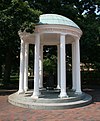From today's featured articleNigel (c. 1100 – 1169) was Treasurer of England under King Henry I, before being appointed to the see, or bishopric, of Ely in 1133. Nigel owed his advancement to his uncle, Roger of Salisbury, a bishop and government minister. Following the accession of Henry I's successor, King Stephen, Nigel remained as treasurer only briefly. He rebelled and deserted to Stephen's rival Matilda, and never regained high office under Stephen. On the king's death, Nigel was returned to the treasurership by the new king, Henry II. In Nigel's second tenure as treasurer, he returned the administration to the practices of Henry I. He withdrew from much of his public work after around 1164, following an attack of paralysis. He was succeeded as treasurer by his son, Richard FitzNeal, whom he had trained in the operations of the Exchequer, or Treasury of England. Most historians have felt that Nigel's administrative abilities were excellent; he is considered to have been more talented as an administrator than as a religious figure. (Full article...)
Recently featured:
Did you know...
|
In the news
On this day...
Colley Cibber (d. 1757) · Hector Berlioz (b. 1803) · Max Born (b. 1882)
More anniversaries:
|
From today's featured list
The Hong Kong Film Award for Best Actress is an award presented annually at the Hong Kong Film Awards. It is given to honour an actress who has delivered an outstanding performance in a Hong Kong film. The 1st Hong Kong Film Awards ceremony was held in 1982, with no formal nomination procedure established; the award was given to Kara Hui for her role in My Young Auntie. After the first award ceremony, a nomination system was put in place whereby no more than five nominations are made for each category and each entry is selected through two rounds of voting. Maggie Cheung (pictured) holds the title for the most awards received having been honoured on five separate occasions. Sylvia Chang holds the record for the most nominated actress with ten nominations. Since its inception, 81 actresses have been nominated for the award with 26 actresses winning at least one of the 36 awards. (Full list...)
Today's featured picture

|
Meripilus giganteus is a polypore fungus in the family Meripilaceae. It causes a white rot in various types of broadleaved trees, particularly beech. This bracket fungus is often found in large clumps at the base of trees, although fruiting bodies are sometimes found some distance from the trunk, parasitizing the roots. M. giganteus has a circumboreal distribution in the Northern Hemisphere, and is widely distributed in Europe. In the field, it is recognizable by the large, multi-capped fruiting body, as well as its pore surface that quickly darkens black when bruised or injured. Photograph: Michael Gäbler
Recently featured:
|
Other areas of Wikipedia
- Community portal – Bulletin board, projects, resources and activities covering a wide range of Wikipedia areas.
- Help desk – Ask questions about using Wikipedia.
- Local embassy – For Wikipedia-related communication in languages other than English.
- Reference desk – Serving as virtual librarians, Wikipedia volunteers tackle your questions on a wide range of subjects.
- Site news – Announcements, updates, articles and press releases on Wikipedia and the Wikimedia Foundation.
- Village pump – For discussions about Wikipedia itself, including areas for technical issues and policies.
Wikipedia's sister projects
Wikipedia is hosted by the Wikimedia Foundation, a non-profit organization that also hosts a range of other projects:
| |
Commons Free media repository |
|
MediaWiki Wiki software development |
|
Meta-Wiki Wikimedia project coordination |
| |
Wikibooks Free textbooks and manuals |
|
Wikidata Free knowledge base |
|
Wikinews Free-content news |
| |
Wikiquote Collection of quotations |
|
Wikisource Free-content library |
|
Wikispecies Directory of species |
| |
Wikiversity Free learning materials and activities |
|
Wikivoyage Free travel guide |
|
Wiktionary Dictionary and thesaurus |



